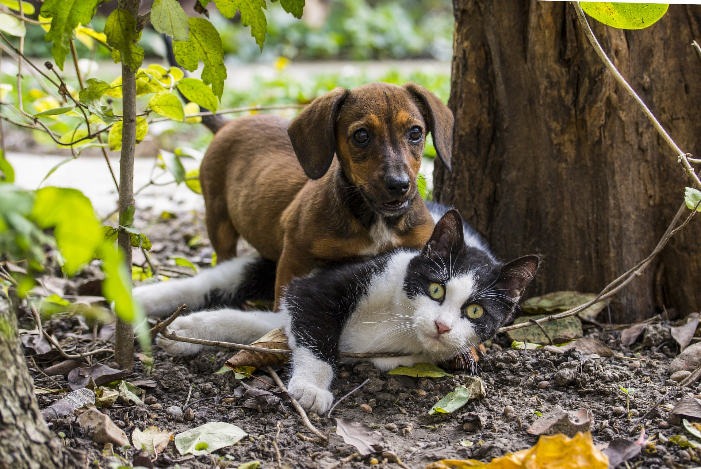
Benefits of a Family Pet
There are many benefits to owning a pet. Pets teach children valuable life lessons like responsibility, trust, compassion, respect and patience. While pets offer a lot of benefits to kids, kids also have a lot to offer the pet in your family as well. Both kids and pets enjoy high energy play as well as having a cuddle buddy during nap time.
December 14, 2017 - Author: Tracy Trautner, Michigan State University Extension
If your child asks for a pet, talk with them about responsibility and the permanency of owning a pet. When the “newness” wears off or the puppy/kitten gets older, will they still want to care for the animal? Have they expressed a consistent desire for a pet and understand it will need daily care up and above play time?
Set up and discuss what your child’s pet responsibilities will be ahead of time. Remember, no matter how committed they are at the time of getting a pet, you will have to consider yourself as the backup plan if and when they cannot or will not continue to care for the pet.
One of the major reasons, and an important life skill, for owning a pet is to teach responsibility. Pets require food, water and love. Many, some more than others, require exercise. They also require grooming (brushing develops large muscles of the arm) and bathroom time (walking the dog develops large muscles of your child’s legs and is good for the development of their heart, brain and lungs).
Children over 5 years old can have developmentally appropriate responsibilities in regards to the care of the pet. Children under the age of 4 should be monitored with pets at all times, and children under the age of 10 should not be expected to take care of a dog or cat completely on their own.
A second skill children learn is trust. A pet offers unconditional support when a child (or anyone) is sad, angry or upset. They can teach your child to trust the pet, themselves and build trust in other relationships as well.
Compassion is the third life skill developed. When a child takes care of a pet, they learn to be kind to others through taking care of their furry friend’s basic needs.

Other skills kids learn include:
Bereavement. When a pet passes away, a child will learn about the grieving process.
Respect. Requiring gentle touching and learning about boundaries when the pet is eating and sleeping will develop respect for others in young children, which is a difficult skill to learn at a young age.
Self-esteem. When pets show unconditional love, it boosts a child’s self-esteem. Being responsible also develops self-esteem in young children.
Loyalty. Pets are very loyal and a good example of how to treat others that are important to the child and family.
Physical activity. Walking and throwing a ball is great exercise.
Patience. Sometimes bonding with a pet takes time, as well as teaching tricks and learning good behavior.
Social Skills. Pets are great in helping “break the ice.” On outings, dogs encourage conversations with others and will improve a child’s social skills.
Motivation. Because of all the skills pet ownership provides, young children have a reduced risk of allergies and better grades at school because kids develop internal motivation while caring for their animals.
Empathy. Children growing up with a pet do so with more empathy towards animals and more empathy in general.
Research shows children who live in homes with a dog can possibly have fewer ear infections and respiratory tract infections and require fewer antibiotics, perhaps because the exposure to animals at a young age stimulates the immune system. Research found in the Time article, “Why Dogs and Cats Make Babies Healthier,” indicates that exposure to pet dander could prime babies’ still-developing immune systems and be able to fend off common allergens and bugs. Young children’s immune systems are more capable of facing them. Kids with a dog did better than those with a cat. The exposure has to happen very early in life. More information can also be found in the CBS News article, “Babies with dogs less likely to develop colds, ear infections as infants.”
When thinking of which pet to add to your family, pick one that fits your lifestyle. A fish, turtle or hamster will require less playtime than a cat or dog. If your family travels a lot, then maybe an animal that can be left at home with minimal care would be a good choice. If you prefer to go for long walks and play in the yard, then a dog may be a perfect fit. More information on choosing the right pet can be found in the Michigan State University Extension article, “Which pet is right for me?”
To learn about the positive impact children and families experience due to MSU Extension programs, read our 2016 impact report: “Preparing young children for success” and “Preparing the future generation for success.” Additional impact reports, highlighting even more ways Michigan 4-H and MSU Extension positively impacted individuals and communities in 2016, can be downloaded from the Michigan 4-H website.
This article was published by Michigan State University Extension. For more information, visit http://www.msue.msu.edu To have a digest of information delivered straight to your email inbox, visit http://www.msue.msu.edu/newsletters To contact an expert in your area, visit http://expert.msue.msu.edu or call 888-MSUE4MI (888-678-3464).


 How to resolve AdBlock issue?
How to resolve AdBlock issue? 